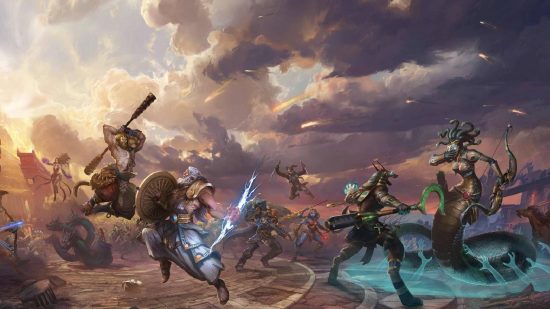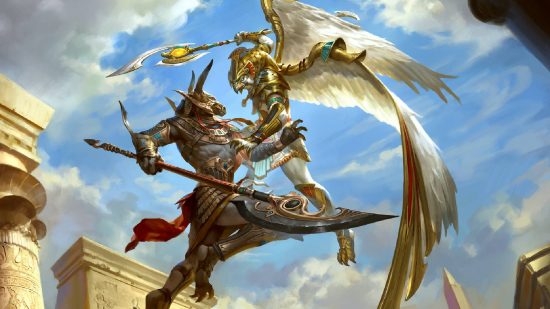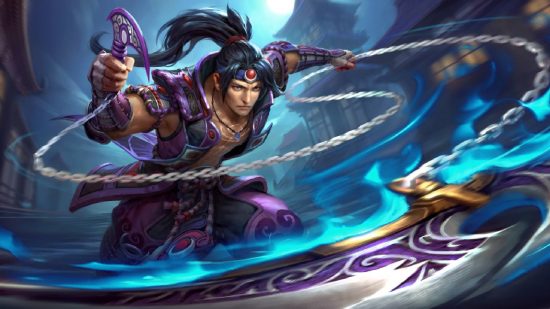Getting into Smite can be a bit daunting, so we’re here today with a guide to Smite builds, and we’re going to go through some of the very best gods you can play as, including the best way to kit them out for maximum effectiveness. Whether you play Shiva, Set, Cthulhu, or any of the many other heroes, we’re going to help you gear up some of the very best of the bunch and get ready for battle.
For even more great Smite guides, be sure to check out our other content on the god-slaying game. We have a Smite characters guide and an extensive Smite tier list to help you choose your next hero.
Here’s our guide to Smite builds.
Smite builds
Smite builds explained
In any match of Smite, you can choose to equip six items, two relics, and two consumable items. So, you create your build from a possible sixteen slots that you fill with a mixture of weapons, consumables, and relics that you then equip at the start of each match. The most important thing is how you spread out items, as some of them are the items you start a match with, meaning you need to improve them throughout the game. For example, assassins should always start with a high-damage weapon, but magic users tend to start with a consumable to regenerate mana. This is split into four categories.
Starter – the items you start with, the essential things your chosen class needs. This is also where you put the first stage of higher-tier weapons so you can build them quicker. It’s also where you slot in healing potions.
Core – secondary items, you may still want to build them up throughout the match or use this slot for more consumables like mana potions if the class you use requires them.
Damage – here’s where you put the weapons that you need later on in the match. High damage weapons, and some equipment that adjusts or improves how those weapons or your stats change over the match.
Defensive – this is another place where you put items that enhance your stats, or can synergise with your class. You can also slot relics here, particularly ones with secondary effects that improve your weapons or abilities.
Smite Set build
Class – assassin
Pantheon – Egyptian
Type – melee, physical
Role – It’s best to use Set in the jungle, but is a good all-rounder and can work great as a solo disrupter
A great assassin, and an aggressive god who focuses on attack power, Set is a force to be reckoned with – makes sense given he’s the Egyptian god of war. He’s one of the faster characters on the map and can cause trouble all around the battleground with the crucial spawn of set ability. Each spawn can also use abilities, and Set’s other skill, sandstorm, lets them blink to any of their spawn. This gives an already fast character impressive coverage to escape quickly and means you can take complete control of a lane.
Set’s passive ability lets them build relentless every time they damage an enemy. However, if Horus is the enemy Set’s attacking, then the god gains two stacks and these each increase Set’s attack speed, making an already dangerous deity absolutely lethal. It also makes Set a great pick against slower gods like Zeus, so if you focus your stats towards attack power and recovery, there’s very little that truly gets in the way of Set.
Recommended Set build
Starter
- Warrior’s axe
- Runeforged hammer
- Chalice of healing
Core
- Jotunn’s vigor
- Sundering axe
- Heartseeker
Damage
- Serrated edge
- Hydra’s lament
- Brawler’s beat stick
- Qin’s sais
Defensive
- Spirit Robe
- Berserker’s shield
- Bulwark of hope
Smite Odin build
Class – warrior
Pantheon – Norse
Type – melee, physical
Role – It’s best to use Odin in the jungle or solo lanes, though he can have a place in sport with his bulky stats and shields
Sure, Odin is less powerful since his introduction thanks to nerfing, but that doesn’t take away from the huge strength this mighty god still possesses, and recent changes see him fly back up the ranks of the meta. Odin’s ability means that when any ally falls in battle, Odin receives a stat buff to attack and movement speed up to five times, which can bring this powerhouse even further forward in godly strength. Odin’s jump ability gives him a bit more movement than you might expect, and the shield skill is useful in a pinch, and said shield can also explode with damage when it expires.
Odin’s final ability is a stomp that launches a spear into opponents. Depending on the amount of times Odin stomps, this has three possible variations. Stomping once grants Odin an attack buff, while stomping twice gives the spear a slight auto aim, homing in on the enemy. Stomping three times allows Odin to move with the spear ready to launch, unless he’s interrupted, if you connect with this attack, it has the stun ability, so it’s a hugely useful tool in your arsenal.
Be sure to stack items to make use of your abilities, so focus on attack power to compliment the already crazy increases to your attack stats. If you’re making use of the shield often, then recovery is essential so you can keep attacking without worry. Odin might seem a bit slow, but with so much power, it’s all about how you manage those stat buffs and using the abilities to your advantage.
Recommended Odin build
Starter
- War Flag
- Mystical Mail
- Chalice of healing
Core
- Heartseeker
- Serrated edge
- Pridwen
Damage
- Berserker’s shield
- Qin’s sais
- The crusher
- Arondight
Defensive
- War banner
- Bulwark of hope
- Genji’s guard
Smite Yemoja build
Class – guardian
Pantheon – Yoruba
Type – ranged, magical
Role – with a focus on defence and healing allies, Yemoja is built for support
An interesting choice for anyone who wants to play a bit more tactically. Yemoja doesn’t have a regular cooldown to her abilities, but instead, her passive uses her own magical resource called Omi. You can pretty much spam all of her abilities because of this, but you do need to gather more Omi as you play. Gather Omi by hitting levels six and fourteen, while you can unlock a third Omi by collecting 300 mp/mp5.
Her passive also works in another way, offering allies a slight auto-healing buff if you hit them with her auto-attack. Her first ability, bouncing bubble, sends out a bubble that bounces twice and slows enemies while dealing damage. If you strike an enemy with both bubble bounces they take 50% damage, meaning this is a great way to do crowd control or deal with several enemies in front of you at once.
Yemoja’s second ability, mending waters, sends out a wave of offence that does even more damage to shielded enemies. When levelled up, this can do up to three times as much to shielded enemies, so this is essential to remember and keep an eye on as the game progresses. Hitting an ally with mending waters heals them and gives them a shield. The final ability, riptide, places a vortex on the ground that can buff allies for movement speed and defence, while enemies that move through the vortex are slowed. Use it wisely!
Recommended Yemoja build
Starter
- Gauntlet of thebes
- Sentinel’s gift
Core
- Sentinel’s boon
- Spirit robe
- Ethereal staff
Damage
- Spear of the magus
- Soul reaver
- Divine ruin
Defensive
- Lotus crown
- Jade emperor’s crown
Smite Cthulhu build
Class – guardian
Pantheon – Great old ones
Type – melee, magical
Role – Cthulu’s mixture of damage and magical attacks make him ideal for solo, though there’s a place in support with the right build
The eldritch horror known as Cthulhu is a slow-moving brawler who relies on the effect known as torment, its passive means that everything Cthulhu does builds up torment in enemies, which eventually drives them to insanity. Its first ability, sanity break, is a cone attack that hits all enemies within range for damage while also slowing attack speed. If Cthulhu feeds on insanity from opponents, you can also reduce damage taken by 0.5% with each turn.
Cthulhu’s second ability, the mire, rains sludge down on enemies and pulses twice. The first pulse casts slow while the second one roots enemies. Both also accumulate torment in enemies, allowing you to build up even more insanity. Finally, rushing terror is the third ability, a dash move that gives Cthulhu a good boost in agility compared – a welcome addition to the normally sluggish brute.
While an already slow but effect-heavy hero, Cthulhu’s ultimate makes it a giant version of itself that can rain down terror on everyone in the area. Any build should focus on high defence and recovery, allowing Cthulhu to spend more time in the thick of the action and build torment up with as many foes as possible. it’s never going to be particularly agile, so don’t even worry about it. Instead, use it as a tank to disrupt problem areas and defend lanes.
Recommended Cthulu build
Starter
- Chalice of healing
- Gauntlet of thebes
- Sentinel’s gift
Core
- Chronos’ pendant
- Bulwark of hope
- Genji’s guard
Damage
- Ethereal staff
- Warlock’s staff
Defensive
- Witchblade
- Spirit Robe
- Sovereignty
Smite Kukulkan build
Class – mage
Pantheon – Maya
Type – ranged, magical
Role – he’s best to use Kukulkan on the middle lane, with a possibility of solo if the build focuses on attack power
A flying serpent with an amazing design, Kukulkan is a mage that focuses on magical ranged attacks that can cause some impressive amounts of damage if used properly. His passive power of the wind jewel slowly increases magical power by 4% in line with your maximum mana, making mana collection absolutely essential, though it does mean that by the end of a match, Kukulkan can deal some serious ranged damage.

His first ability, zephyr, is a projectile that can cause slow to enemies while also hitting every enemy in his path for damage. Like most of Kukulkan’s abilities, this isn’t a move you should spam, but instead play it with precision and accuracy, as this can really disrupt the enemy team and go a long way to protecting a lane. Next up, the ability slipstream gives Kukulkan a speed boost and allows him to shed slow, an essential way to get in, deal heavy damage, and then move back to avoid getting hit.
Finally, whirlwind is a heavy AoE ability that causes a whirlwind to appear that hits enemies for progressively greater damage the more they’re hit. If you can partner this with slow, you can wipe out enemies easily. Any build for Kukulkan should focus on magical attack power and speed, so you can dip in and out of combat areas as quickly as possible, and deal tremendous damage from afar.
Recommended Kukulkan build
Starter
- Book of souls
- Chalice of healing
- Purification beads
- Book of Toth
Core
- Polynomicon
- Divine ruin
- Soul reaver
Damage
- Chronos’ pendant
- Vision shard
- Aegis amulet
Defensive
- Pendulum of ages
- Conduit gem
Smite Tsukuyomi build
Class – Japanese
Pantheon – assassin
Type – melee, physical
Role – With his focus on offensive capabilities, Tsukuyomi jungle or solo lanes best
One of the newer gods, Tsukuyomi, is an assassin who focuses on physical attack. His passive ability shingetsu & mangetsu is named after the two swords he wields, and grants extra buffs every time an auto-attack connects. These award either a 50% cleave increase or restore mana, while the other deals bonus damage and restores health. This is a fantastic way to slowly pick away at enemies while keeping some healing abilities active.
The first ability, dark moon shuriken, fires out one of the shuriken, while Tsukuyomi can retrieve it if the affected god is still within range. After using this ability, Tsukuyomi’s next auto attack becomes ranged, while also stealing movement speed from enemies, and casting slow in tandem with making Tsukuyomi move faster. The second ability, Kusarigama, is a three-pronged attack, swiping left, right, and then forwards. You need to be up close to make the most of this, so it’s a great move for crowd control.
Finally, the ability silver moon caltrops places a crescent moon-shaped set of traps on the floor, ready to deal damage and cast slow. A great way to guard your lane, this ability also allows Tsukuyomi‘s next auto attack to become ranged, and deals physical damage. As Tsukuyomi’s auto attack isn’t the best, any build should instead focus on ability power and movement, allowing you to make the most of those deadly shuriken and steal movement as much as possible.
Recommended Tsukuyomi build
Starter
- Runeforged hammer
- Chalice of healing
- Warrior’s axe
Core
- Jotunn’s wrath
- Brawler’s beat stick
- Gladiator’s shield
Damage
- Heartseeker
- Serrated edge
- Hydra’s lament
- Brawler’s beat stick
Defensive
- Bulwark of hope
- Mantle of discord
- Spirit robe
That’s it for our Smite builds guide for now gamers, but we’ll be back with more heroes and will finely tune these build guides as the game updates in the future. If there’s a hero you’re desperate to see here, or an item you think needs mentioning, be sure to let us know over at Pocket Tactics Twitter. For now, why not check out our Smite servers guide next?






